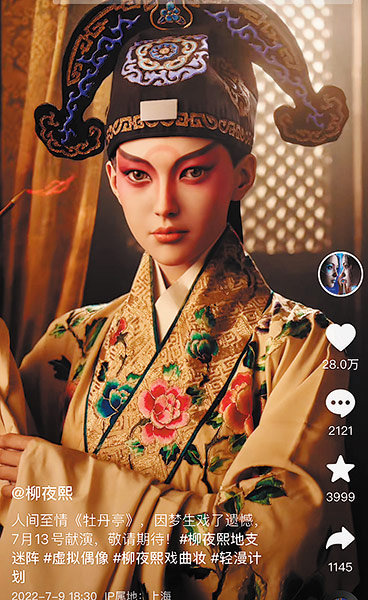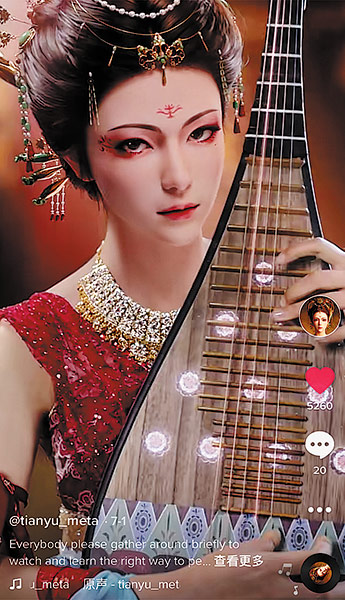July 28, 2022
BEIJING – From a maiden modeled on Mogao’s murals to others inspired by opera, AI avatars are being used to promote traditional culture, Deng Zhangyu reports.
Her face is angelic. Her presence enigmatic. She can be a poet’s muse at daybreak and a musician’s inspiration by sundown. She can dance and she can sing, and she does bring history alive like no other. Meet Tianyu, a virtual maiden on a mission to acquaint the world with Chinese heritage and culture, who has garnered millions of followers since her April debut on short video platforms Douyin and TikTok.
Modeled on the flying Apsaras (celestial singers and dancers) of Mogao Caves’ murals in Dunhuang, Gansu province, Tianyu was incubated in a digital studio in a prelude to the fusion of real-world heritage and the metaverse.
She almost immediately began dominating screen time with her lifelike expressions, her nimble-footed jin dance (a unique dance style found in the Mogao murals) and her remarkable skills in playing the pipa (a four-stringed Chinese musical instrument), the latter frequently depicted in the frescoes of the Buddhist caves.
“We wanted to create a virtual human different from the fashionable digital avatars our millennials are so sold on,” says Zheng Yicheng, the manager of Tianyu studio where the digital damsel was born. “Hence, Tianyu has a very traditional countenance and style. She is the beacon of Chinese culture.”

A worker designs details of digital avatar Tianyu’s face on a computer in Beijing. [Photo provided to China Daily]
Tianyu was born and bred to become a class apart. Zheng joined the studio last September and started preparations to create her. In three months, Tianyu was ready to make heads turn. The formal public launch happened on April 22. Within a month of going online, she was on the Douyin hot list.
The digital avatar inspired by Dunhuang flying Apsaras is unique in many ways. The glow on her face, the dark eyebrows, the exquisite mouth and the peach blossom makeup are not merely coincidental, but the result of expert-level research on how women of the Tang Dynasty (618-907) prepped for public appearances.
Female figurines from the dynasty unearthed in Turpan, Xinjiang Uygur autonomous region, are behind Tianyu’s fetching beauty. Even the floral stone and pearl tassel hairpins are based on historical data as are her bejeweled clothes.
A leading “lady” on Douyin, Tianyu has 2.25 million fans, with more than 10 million likes for her videos. The clips, which last from less than a minute to two minutes, tell stories that Tianyu gathered from different pieces of a mural where she was from.

Digital human Ling appears in an advertisement for a brand shampoo. [Photo provided to China Daily]
Netizens are mostly overwhelmed by Tianyu’s stunning beauty and the rich culture behind the stories she shares with them. Some urge her to post more frequently, as if her videos were part of some intriguing television drama they cannot wait to watch. Others keep wondering whether she is a digital avatar or a real person.
“Virtual icons have the amazing ability to grab people’s attention. We are glad to be able to generate awareness about our tradition and culture through digital technology,” says Zheng.
Tianyu is evidently not the first virtual human to have youths glued to their seats. Her contemporaries, ironically much younger than her in terms of history, include Ling and Liu Yexi.
Ling, labeled as “China’s first virtual idol with guofeng (Chinese chic style)”, made her debut on social media platform Sina Weibo and quickly won hundreds of thousands of followers. Her face resembles that of Mulan, a warrior protagonist of a Disney animation of the same name, which was based on the story of Hua Mulan, the Chinese female warrior from ancient times. Ling, however, is a Peking Opera enthusiast.

Virtual avatar Liu Yexi in Kunqu Opera. [Photo provided to China Daily]
Liu Yexi made a bigger splash when she made her debut on Douyin last October. The “virtual beauty blogger “attracted more than 1 million followers and 2 million likes in a single day after posting her first 2-minute video.
Liu’s makeup tutorials blend traditional Chinese beauty routines with modern techniques. She is quite the influencer, who changes her wardrobe in every video and prompts her avid followers to emulate her looks.
In a post on July 9, Liu turned herself into a Kunqu Opera actor. Until Monday, the video had received more than 280,000 likes. Many commented on the inimitable style of the opera, which evolved from the local melody of Kunshan, Suzhou, Jiangsu province. As one of the oldest drama styles, Kunqu Opera was listed as a Masterpiece of the Oral and Intangible Heritage of Humanity by UNESCO in 2001.
According to Liu’s creator Liang Zikang, most followers of digital humans are young and find it easy to grasp the concept of the metaverse, an immersive virtual world for real-time interactions and experiences.

Digital creation Tianyu plays the pipa, a four-stringed Chinese musical instrument. [Photo provided to China Daily]
Last October, a plan was launched by the National Radio and Television Administration to promote wider application of virtual anchors and animated presenters in news broadcasts, weather forecasts, variety shows and science and education programs.
In May this year, the State Council launched a regulation to encourage the application of digital technologies in the promotion of Chinese culture.
Echoing policy support, many cultural organizations, media groups and even cities have begun to produce their own digital ambassadors or spokespersons.
Last week, the city of Qingdao in Shandong province launched its digital spokesperson. The National Museum of China too inducted a digital employee this month. Media outlets such as Xinhua and CCTV already have digital anchors.
Cheng Zuo, marketing director of Xiangxin Technology in Beijing, says more and more companies and organizations are willing to pay for the services of virtual humans. “China is stepping into the booming phase of digital beings. We need to invest in better technologies for more lifelike presentations,” Cheng adds.


